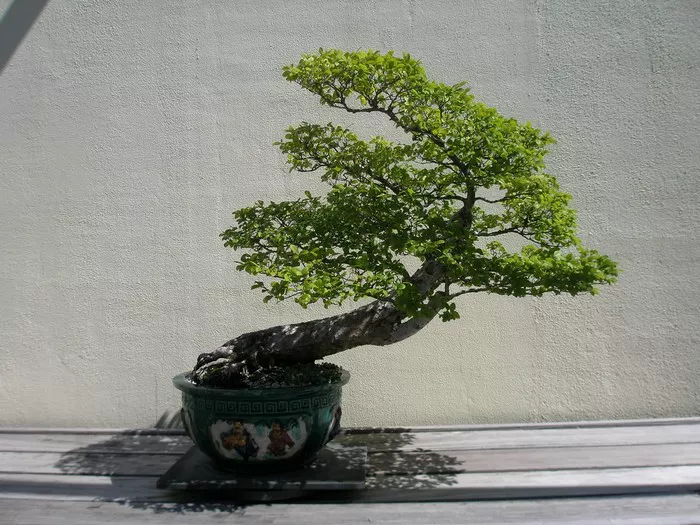Chinese Elm (Ulmus parvifolia) bonsai, with its elegant appearance and resilience, has become a favorite among bonsai enthusiasts worldwide. Originating from China, Taiwan, Japan, and Korea, this species is revered for its small, glossy leaves, intricate branching patterns, and ability to thrive both indoors and outdoors. Cultivating a Chinese Elm bonsai requires patience, dedication, and a solid understanding of its unique care requirements. In this comprehensive guide, we will delve into essential care guidelines, troubleshooting common problems, and nurturing these miniature masterpieces.
Essential Care Guidelines
1. Placement and Sunlight
Proper placement is crucial for the health and vitality of your Chinese Elm bonsai. While these trees can tolerate a range of lighting conditions, they thrive in bright, indirect sunlight. Place your bonsai near a south-facing window where it can receive ample sunlight throughout the day. Avoid exposing it to harsh midday sun, as this can scorch the leaves. If growing your bonsai outdoors, provide partial shade during the hottest part of the day to prevent leaf burn.
2. Watering
Maintaining proper moisture levels is essential for the health of your Chinese Elm bonsai. Check the soil daily, and water thoroughly when the top inch feels dry to the touch. Ensure that water reaches all parts of the root system by watering until it begins to drain from the bottom of the pot. Avoid overwatering, as this can lead to root rot and other issues. In hot, dry climates, you may need to water more frequently, while in cooler climates, you may water less often.
3. Humidity
Chinese Elm bonsai thrive in moderately humid environments. To increase humidity levels, place a humidity tray filled with water and pebbles beneath the bonsai. Misting the foliage regularly can also help maintain adequate humidity levels, especially during dry winter months when indoor heating systems can cause the air to become overly dry.
4. Temperature
Chinese Elm bonsai prefer moderate temperatures between 60-80°F (15-27°C). Protect your bonsai from extreme heat or cold, as sudden temperature fluctuations can stress the tree and compromise its health. During winter, provide protection from freezing temperatures by bringing outdoor bonsai indoors or providing adequate insulation.
5. Soil and Fertilization
Well-draining soil is essential for Chinese Elm bonsai to prevent waterlogged roots and promote healthy growth. Use a bonsai-specific soil mix consisting of a combination of akadama, pumice, and lava rock. Repot your bonsai every 2-3 years to refresh the soil and encourage root growth.
Fertilize your Chinese Elm bonsai during the growing season, from spring to fall, using a balanced liquid fertilizer diluted to half strength. Apply fertilizer every 2-4 weeks to provide essential nutrients for healthy growth. Reduce fertilization frequency during the dormant winter months.
6. Pruning and Shaping
Regular pruning and shaping are necessary to maintain the desired form and silhouette of your Chinese Elm bonsai. Use sharp bonsai shears to remove unwanted growth, including branches, leaves, and shoots. Prune your bonsai throughout the growing season to encourage branching and refine its shape.
When shaping your Chinese Elm bonsai, consider the classic bonsai styles, such as informal upright, formal upright, slanting, cascade, and semi-cascade. Use wiring techniques to guide branches into the desired position, taking care not to damage the delicate bark.
7. Repotting
Repotting is an essential aspect of Chinese Elm bonsai care and should be performed every 2-3 years to prevent the tree from becoming root-bound. Repot your bonsai in early spring before new growth begins, using a bonsai soil mix that promotes good drainage and aeration. Carefully remove the tree from its pot, prune the roots, and repot it in a slightly larger container. After repotting, place the bonsai in a shaded location and water thoroughly to help it recover from the transplant shock.
Troubleshooting and Common Problems
Despite your best efforts, Chinese Elm bonsai may encounter various issues that require attention. Here are some common problems and troubleshooting tips:
1. Leaf Yellowing: Yellowing leaves can indicate overwatering, underwatering, or nutrient deficiencies. Adjust your watering schedule and fertilization regimen accordingly. Ensure that your bonsai is receiving adequate sunlight.
2. Leaf Drop: Excessive leaf drop can occur due to environmental stress, such as sudden temperature changes or inadequate humidity. Maintain stable growing conditions and provide proper care to prevent leaf drop.
3. Pest Infestations: Chinese Elm bonsai are susceptible to pests such as aphids, scale insects, and spider mites. Inspect your bonsai regularly for signs of pest infestation, and treat affected plants promptly with insecticidal soap or neem oil.
4. Root Rot: Root rot can occur if the bonsai is consistently overwatered or if the soil does not drain well. Allow the soil to dry out slightly between waterings and repot your bonsai using a well-draining soil mix if root rot is suspected.
5. Fungal Diseases: Fungal diseases such as powdery mildew and leaf spot can affect Chinese Elm bonsai, especially in humid conditions. Improve air circulation around the bonsai, avoid overhead watering, and treat affected plants with fungicides as needed.
Conclusion
By following these essential care guidelines and troubleshooting tips, you can ensure that your Chinese Elm bonsai thrives and remains a stunning focal point in your home or garden for years to come. With patience, attention to detail, and a love for the art of bonsai, you can enjoy the beauty and tranquility of these miniature trees in your own living space.


